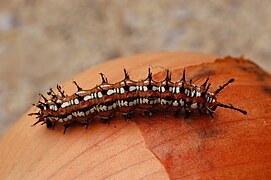Euptoieta claudia
| Euptoieta claudia | ||||||||||||
|---|---|---|---|---|---|---|---|---|---|---|---|---|

Euptoieta claudia |
||||||||||||
| Systematics | ||||||||||||
|
||||||||||||
| Scientific name | ||||||||||||
| Euptoieta claudia | ||||||||||||
| ( Cramer , 1775) |
Euptoieta claudia is a butterfly from theNorth and Central America ofthe noble butterfly family (Nymphalidae).
features
butterfly
The moths reach a wingspan of 45 to 80 millimeters, with the females being slightly larger than the males. In both sexes, the orange or yellow-brown wing tops are patterned with black spots and lines. A black row of dots can be seen in the submarginal region . The black veins stand out clearly. The hem is dark brown. The basal regions are darkened brownish. The undersides of the wings are marbled in light brown to reddish brown. Mother-of-pearl spots are missing.
Caterpillar, pupa
Fully grown caterpillars are reddish in color and show a thin, interrupted white topline as well as broad side ridges and side stripes of the same color. Each body segment is provided with branched black thorns. There are two short, thin, straight horns on the head, which end like a piston. The doll is designed as a falling doll and has a creamy white color. More or less strongly developed black-brown stripes can be seen on the wing sheaths. Small black dots and orange-colored pointed bumps stand out from the entire body surface.
Similar species
Euptoieta hegesia differs in the poorly marked , yellowish basal region on the upper side of the hind wing and the faded marbling on the underside of the hind wing.
distribution and habitat
The distribution of Euptoieta claudia extends from southern Canada across the USA to the West Indies . In Nebraska , Arkansas and Florida it is represented by the subspecies Euptoieta claudia daunius . The species prefers to colonize open grass and bush landscapes.
Way of life
The moths form three generations a year in the northern ranges, which fly from April to October. Continuous generations are formed in the south. They like to suckle on flowers for food intake and sometimes take up minerals from damp places in the earth. The eggs are laid on the top of the leaves or on the stalks of the food plant. The caterpillars feed on the flowers and leaves of various plants, for example violets ( viola ), flax ( linum ), passion flowers ( passiflora ), sedum , moon seeds ( menispermum ) or plantain species ( Plantago ).
Individual evidence
- ↑ Information on Art
- ↑ Markku Savela: Tanaecia Butler (1869) - distribution. In: Lepidoptera and some other life forms. Retrieved January 6, 2019 .
- ↑ James A. Scott: The butterflies of North America. Stanford University Press, Stanford, California 1986, ISBN 0-8047-1205-0 , pp. 335/336
literature
- James A. Scott: The butterflies of North America. Stanford University Press, Stanford, California 1986, ISBN 0-8047-1205-0
Web links
- butterfliesofamerica - Butterflies of America




